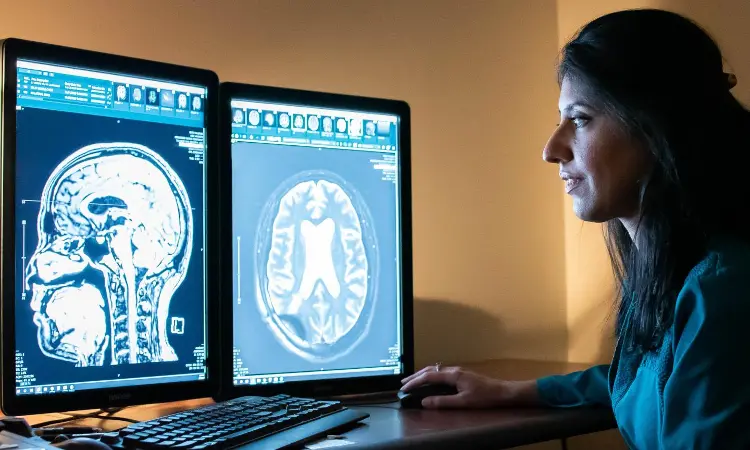- Home
- Medical news & Guidelines
- Anesthesiology
- Cardiology and CTVS
- Critical Care
- Dentistry
- Dermatology
- Diabetes and Endocrinology
- ENT
- Gastroenterology
- Medicine
- Nephrology
- Neurology
- Obstretics-Gynaecology
- Oncology
- Ophthalmology
- Orthopaedics
- Pediatrics-Neonatology
- Psychiatry
- Pulmonology
- Radiology
- Surgery
- Urology
- Laboratory Medicine
- Diet
- Nursing
- Paramedical
- Physiotherapy
- Health news
- Fact Check
- Bone Health Fact Check
- Brain Health Fact Check
- Cancer Related Fact Check
- Child Care Fact Check
- Dental and oral health fact check
- Diabetes and metabolic health fact check
- Diet and Nutrition Fact Check
- Eye and ENT Care Fact Check
- Fitness fact check
- Gut health fact check
- Heart health fact check
- Kidney health fact check
- Medical education fact check
- Men's health fact check
- Respiratory fact check
- Skin and hair care fact check
- Vaccine and Immunization fact check
- Women's health fact check
- AYUSH
- State News
- Andaman and Nicobar Islands
- Andhra Pradesh
- Arunachal Pradesh
- Assam
- Bihar
- Chandigarh
- Chattisgarh
- Dadra and Nagar Haveli
- Daman and Diu
- Delhi
- Goa
- Gujarat
- Haryana
- Himachal Pradesh
- Jammu & Kashmir
- Jharkhand
- Karnataka
- Kerala
- Ladakh
- Lakshadweep
- Madhya Pradesh
- Maharashtra
- Manipur
- Meghalaya
- Mizoram
- Nagaland
- Odisha
- Puducherry
- Punjab
- Rajasthan
- Sikkim
- Tamil Nadu
- Telangana
- Tripura
- Uttar Pradesh
- Uttrakhand
- West Bengal
- Medical Education
- Industry
Dual energy CT bests ultrasound for gout diagnosis; claims study

Chandigarh’s PGI Builds India’s Largest Unified Neurology and Neurosurgery Facility
CREDIT
Caylie Silveria/West Virginia University
In a recent development, Feet/ankles or knees DECT alone has shown the best overall accuracy for gout diagnosis. Researchers further highlighted that the DECT–US combination or multiple joint imaging offered no additional increase in overall diagnostic accuracy.
The study findings have been put forth in Rheumatology.
Gout is characterized by an inflammatory response to the deposition of monosodium urate (MSU) crystals in the joints and soft tissue, which leads to acute or chronic arthropathy and gouty tophi formation. Diagnosis can be made on clinical and biochemical bases, and definite diagnosis requires microscopic demonstration of MSU crystals from the aspiration of the joint fluid, a method that is invasive and may have false negative results.
Using prospectively collected data from an outpatient rheumatology clinic at a tertiary-care hospital, the research team examined the diagnostic accuracy of either modality alone or their combination, by anatomical site (feet/ankles and/or knees), for the diagnosis of gout. They used two standards: (i) demonstration of monosodium urate crystals in synovial fluid (gold), and (ii) modified (excluding DECT and ultrasound) 2015 ACR–EULAR gout classification criteria (silver).
Data analysis revealed the following facts.
- Of the 147 patients who provided data, 48 (33%) had synovial fluid analysis performed (38 were monosodium urate-crystal positive) and mean symptom duration was 9.2 years.
- One hundred (68%) patients met the silver standard. Compared with the gold standard, diagnostic accuracy statistics for feet/ankles DECT, feet/ankles ultrasound, knees DECT and knees ultrasound were, respectively: sensitivity: 87%, 84%, 91% and 58%; specificity: 100%, 60%, 87% and 80%; positive predictive value: 100%, 89%, 97% and 92%; negative predictive value: 67%, 50%, 70% and 33%; area under the receiver operating characteristic curve: 0.93, 0.72, 0.89 and 0.66.
- Combining feet/ankles DECT with ultrasound or knees DECT with ultrasound led to a numerically higher sensitivity compared with DECT alone, but overall accuracy was lower.
- Similarly, combining imaging knees to feet/ankles also yielded a numerically higher sensitivity and negative predictive values compared with feet/ankles DECT alone, without differences in overall accuracy.
- Findings were replicated compared with the silver standard, but with lower numbers.
For the full article follow the link: https://doi.org/10.1093/rheumatology/keaa923
Primary source: Rheumatology
Dr Satabdi Saha (BDS, MDS) is a practicing pediatric dentist with a keen interest in new medical researches and updates. She has completed her BDS from North Bengal Dental College ,Darjeeling. Then she went on to secure an ALL INDIA NEET PG rank and completed her MDS from the first dental college in the country – Dr R. Ahmed Dental College and Hospital. She is currently attached to The Marwari Relief Society Hospital as a consultant along with private practice of 2 years. She has published scientific papers in national and international journals. Her strong passion of sharing knowledge with the medical fraternity has motivated her to be a part of Medical Dialogues.
Dr Kamal Kant Kohli-MBBS, DTCD- a chest specialist with more than 30 years of practice and a flair for writing clinical articles, Dr Kamal Kant Kohli joined Medical Dialogues as a Chief Editor of Medical News. Besides writing articles, as an editor, he proofreads and verifies all the medical content published on Medical Dialogues including those coming from journals, studies,medical conferences,guidelines etc. Email: drkohli@medicaldialogues.in. Contact no. 011-43720751


